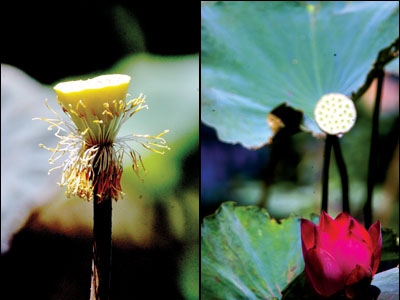Nature Trail
The sacred lotus
  Olli,
nelum, manel, who hasn’t heard of these beautiful fragrant blossoms?
They are three of the most spectacular plants in the aquatic
environments and today we thought of bringing you some interesting facts
about one of these blossoms which you are no doubt familiar with,
especially if you are a Buddhist, because its closely associated with
Buddhism. Olli,
nelum, manel, who hasn’t heard of these beautiful fragrant blossoms?
They are three of the most spectacular plants in the aquatic
environments and today we thought of bringing you some interesting facts
about one of these blossoms which you are no doubt familiar with,
especially if you are a Buddhist, because its closely associated with
Buddhism.
The lotus (Nelumbo nucifera), an aquatic perennial (a plant lasting
through the years) is also known as the Indian lotus, sacred lotus, bean
of India, and the sacred water lily. It is sometimes classified
scientifically as Nymphaea nelumbo. In vernacular (commonly spoken
language in a country or place), it is popularly called the nelum mala.
The lotus plant is naturalised in southern Asia and Australia. It was
introduced to Egypt at the time of the Persian invasion. Ancient
Egyptians venerated the blue water lily (Nymphaea caerulea). The nelumbo
lotus is native to a huge area from modern Vietnam to Afghanistan.
Even though lotus blossoms are called water lilies, they are not true
water lilies and neither do they belong to the genus Nymphaea lotus (in
the family of Nymphaeaceae) which has two species in our country namely
manel and olu as they are called in Sinhala.
Originating in ancient Egypt, the lotus blossom has been featured in
many legends and also played an important part in Egyptian religion. It
is just as much as significant to Buddhism and Hinduism today.
The Chinese also revere the lotus as a symbol of purity and elegance
while in Hindu mythology the lotus (padma) is associated with creation.
It is also associated with gods such as Vishnu, Brahmana and goddesses
Sarasvati and Lakshmi. God Vishnu is often described as the Lotus Eyed
One. The unfolding petals of the blossom are said to signify the
expressions of the soul.
|

The seeds within the pod are edible |
Borrowing from Hinduism, the Buddhists too believe that the lotus
blossoms represent purity of body, speech and mind. The flowers which
rise above the muddy water are believed to symbolise one’s ability to
rise above the muddy waters of attachment and desires in life.
The Buddha is often depicted seated on a lotus. He is also believed
to have been born with the ability to walk and is often depicted with
lotus flowers blossoming with every step He took.
The legend of the lotus is as old as civilization; may be even older
with stories of lotus eaters and lotus worshippers from prehistoric
times still floating around as oral tales and also as crude drawings.
The lotus plant which is believed to have originated in Egypt,
Mesopotamia and the Indus Valley of the Indian subcontinent is a plant
which grows abundantly in our land.
|

The cone-shaped seed head. |
Rising from the depths of muddy swamps and rivers, this aquatic plant
attracts the attention of many mostly due to its spectacular blossom
with 15 or more oval-shaped petals and a peculiar looking seedcase at
the centre.
While the roots are in the soil at the bottom of the pond, river or
swamp it’s growing in, the leaves float on the top. The leaves are as
large as 60 cm in diameter. Normally the plant grows to a height of
about 150 cm and spread horizontally up to three metres.
The exquisite flower which grows on thick stems rises about seven
centimetres above the water. Separate, long tubular stalks each support
a showy flower which is about 20 cm in diameter, and a large leaf.
These beautiful, fragrant flowers bloom only for three days and that
too in the early mornings. Then the petals fade and fall, one by one
into the water. However, the cone-shaped seed head or pod stay for a
long time. The seeds within the pod have very hard and impermeable
(water or liquid proof) coats. Would you believe that these seeds can
germinate (cause to sprout or grow) even after 400 years?
These aquatic beauties vary in colour with pink and white being the
most popular. But some water lilies native to Egypt have blue flowers
while those native to North America are said to be yellow in colour.
The different colours are said to have different meanings. For
instance white lotus flowers are said to represent a state of spiritual
perfection and total mental purification while the red lotus signifies
the original nature and purity of heart.
It is known as the lotus of love, compassion, passion and all the
other qualities of the heart. The blue lotus is said to signify wisdom
and symbolise victory of the spirit over the senses.
The pink lotus is called the supreme lotus and is generally reserved
for the highest deity. In fact it is associated with the Buddha himself.
Next time you pick a nelumbo lotus or offer it at the temple or kovil,
remember how special this flower is.
Fact file
* Water lilies or lotuses listed under the genus Nymphaea have round
leaves with a notch at one side, where the leaf is attached to the
stalk.
* Buddhist Sutras say the lotus, especially (of the Nelumbo genus)
has four virtues; scent, purity, softness and loveliness.
* Plants can be propagated from seeds or roots.
* The padma (Sanskrit and Tibetan name for lotus or nelum) is the
best recognised motif in Buddhism.
* All other aquatic plants float above water, but the lotus is the
only one to rise above water due to the strength of its stalks.
|

Large leaves float in the water. |
* Even though the lotus plant grows in muddy waters, its leaves are
believed to have a self-cleaning property in them. This natural ‘self’
cleaning mechanism which is now known as the ‘lotus effect’ was
discovered by a botanist named Wilhelm Barthlott in 1982. He holds the
patent rights.
* Even before the advent of Buddhism in China, the lotus was honoured
as the ‘plant of summer.’ It was an emblem of purity, fruitfulness (due
to its numerous seeds) and creative power.
* Lotus blossoms are used as religious symbols, decoration or funery
(funeral) offerings, making the flower a symbolic part of man’s life and
philosophy.
* The flowers, seeds, young leaves and roots (rhizomes) are all
edible (fit to be eaten).
* Petals of the lotus flowers are used as garnish while the stamens
are dried and used as a fragrant herbal tea. Rhizomes are used in soups
or stir-fried and eaten. Lotus roots are said to be rich in dietary
fibres, Vitamin C, copper and phosphorus but low in saturated fat. Seeds
are sometimes boiled and made into a paste or eaten like pop-corn.
* The huge leaves are used to wrap food by some.
* The distinctive seed heads are dried and used for decorative
purposes - like in flower arrangements.
* The plant has the ability to regulate the temperature of its
flowers to within a normal range like humans and other warm-blooded
animals.
* A lotus plant has been germinated from a 1,300 year old seed
obtained from a lotus fruit recovered from a lakebed in northern China. |
